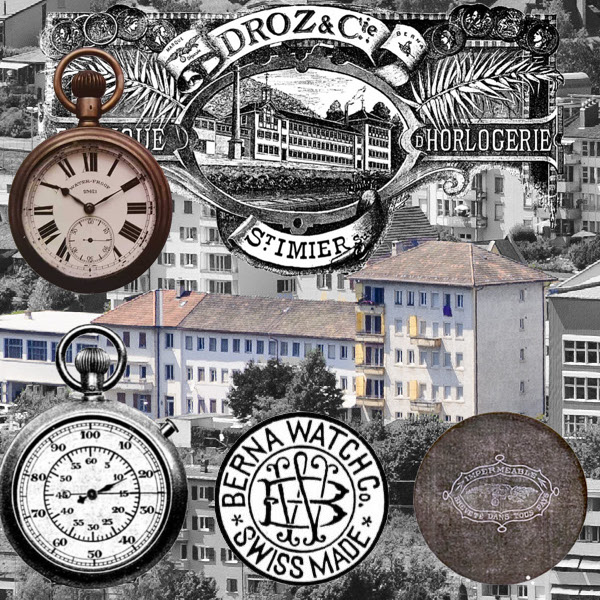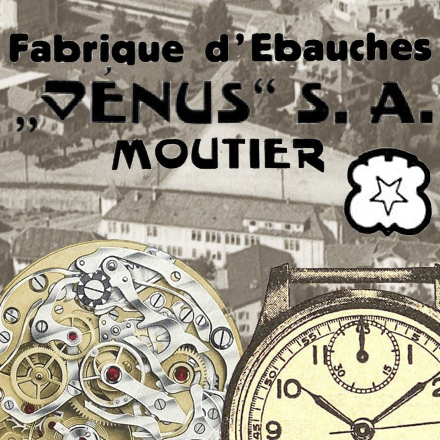Most watch enthusiasts are familiar with Pierre Jaquet-Droz, the famous maker of watches and automatons from Neuchâtel in the 18th century. And most fine watch buyers have heard of the modern Jaquet Droz brand, well known for their artful faces with offset dials. But very few remember what came between: As many as 150 manufacturers came together in a cooperative to produce over 2,000 Jaquet-Droz watch models, selling over 5 million watches per year!

This article accompanies Episode 6 of The Watch Files, a podcast from Europa Star and Grail Watch. Listen to “06 The Forgotten History of Jaquet-Droz, An Experiment in Cooperation“ and subscribe now!
From Établisseurs to Manufactures

For over 250 years, watchmaking in Switzerland was distributed across hundreds of tiny workshops. Each of these établisseurs handled just a few components or watches at a time. Some employed dozens of workers in dedicated buildings or workshops, but many were just a single part-time watchmaker. Even today, many Swiss people remember their mother or father assembling movements at the workbench in their home. And the image of a watchmaker toiling alone in the Jura mountains remains a key selling point for Swiss watchmaking.
This system of établissage allowed Switzerland and Germany to scale production and sell watches all over the world. It distributed watchmaking skills and provided extra income for farmers who were often shut in all winter. And it made remote locations like the Vallée de Joux, Val-de-Travers, and Glashütte into watchmaking hubs even to this day. But it would not last.
After the 1876 International Exposition in Philadelphia, the Swiss industry realized that mechanization and mass production was necessary to advance the industry. Even so, traditional watchmaking in the Jura Triangle was resistant to change. Omega had to move from La Chaux-de-Fonds to Biel/Bienne to set up a modern factory, and Longines took decades to mechanize. But Georges Favre-Jacot at Zenith in Le Locle and Henri Sandoz in Tavannes showed the way forward, and the industry expanded dramatically early in the 20th century.

The industry had built up so much capacity that, between World War I and the Great Depression, the Swiss were producing more watches than the market could absorb. Watch exports dropped from 307 million Swiss francs in 1929 to just 86 million two years later, and average unit prices dropped by half. In a panic, the Swiss industry experienced rapid consolidation, with the strongest movement producers joining Ebauches SA and watch companies joining together as SSIH and ASUAG. Supported by the Swiss banks and Cantonal governments, these companies rationalized production and came to dominate the industry.

Image: Europa Star 4, 1960
Coopérative de Fabricants Suisses d’Horlogerie and Jaquet-Droz
After World War II, the giants of the Swiss watch industry was well-positioned to compete on the world stage. But there were still hundreds of tiny companies producing watches, and these could not participate in the new global watch trade. Many of the companies merged or formed holding companies to better compete, while others simply joined ASUAG or SSIH. But the smallest producers were still left out.
In 1960, after a long series of discussions, many tiny watchmakers met in Neuchâtel to negotiate a new arrangement. On April 4, 70 établisseurs signed on to form something new. Known as the Coopérative de Fabricants Suisses d’Horlogerie, it was not a holding company or even a federated organization. Rather, it was a self-supporting cooperative to provide purchasing, finance, and marketing support to these member companies.
The explicit goal of the Coopérative was to respond to the branding and pricing challenges facing small manufacturers, and to enable them to compete with Ebauches SA and ASUAG. It would also enable bulk purchasing of watch movement components and raw materials and ultimately would develop in-house movements.
By 1963, the Coopérative was already ordering watch movements in bulk for member companies. But it also set up two assembly lines of its own in Lausanne so members could have access to uniform in-house movements. Two different movements were produced in 1963: A compact 6.75 by 8 ligne movement and a larger 11.5 ligne movement. In-house production was already over 569,000 movements in 1963, compared to 4.2 million ebauches ordered collectively by members. A third assembly line for a 5.5 ligne movement would be added in 1966.

But how could the product of this many companies be marketed in a uniform manner? This required the creation of a shared brand, and a special one had just become available. Pierre Jaquet-Droz was a pioneering watchmaker in the Principality of Neuchâtel in the 18th century, legendary for his automatons and complicated watches. They were so lifelike that some accused him of witchcraft! His name was revered, and appears everywhere in the Swiss Jura.

Image: Europa Star Eastern Jeweler 85, 1964
Many companies had used the Jaquet-Droz name in the past, but never with much success. The latest Jaquet Droz SA watch and clock company failed in 1963. Dr. Charles-Edouard Virchaux, President of the Coopérative, seized the opportunity and registered Jaquet-Droz as the shared name for the products of his member companies. It was an eminently appropriate name, historically linked to Neuchâtel and the Jura region and symbolic of the best of Swiss workmanship. This news was uncovered in 1964 by Europa Star and confirmed in their next issue by Dr. Virchaux himself.
The practicalities of a shared brand posed many challenges for the new cooperative. They quickly established a quality control center in Bienne to check materials and finishing and ensure that all watches would meet the standards set by the group. The Bienne operation also included a jewelling workshop by 1964, and the plan was to build hairsprings there to supply cooperative members.
One key requirement for the Coopérative was price controls. They required all members to supply copies of every invoice to the headquarters for accounting, and no member was allowed to undercut pre-set pricing levels. This was critical to members, since many had experienced bruising price wars up to that point, and every remembered the “dumping” that happened in the 1930s. These price controls might have even been the key that allowed the Coopérative to be set up in the first place.
Over 1,000 Jaquet-Droz Models
The Coopérative also tried to put together a comprehensive collection of Jaquet-Droz watches, but this would prove more challenging. The initial concept would simply to request manufacturers to provide samples of their Jaquet-Droz watches for display and promotion from the headquarters in Bienne. These would be photographed and shared in advertisements starting in 1965, with special focus given to the arrow logo, the claim of 150 manufacturers, and a dizzying number of models.

Image: Europa Star Eastern Jeweller 105, 1968
Jaquet-Droz had a watch for everyone. The company boasted that it had “the widest scale of products in the world” and that “every watchmaker will find just the watches he needs for his own particular market” at “a very wide range of prices.” There were thin dress watches, fashionable square models, twisted, tapered, and horn lugs, and dive watches, an increasingly important trend in the late 1960s.
One highly unusual model, pictured at right, is a 1968 dive watch that uses components sourced outside the Coopérative: The EPSA Super Compressor dual-crown case and ETA’s Cal. 2538. Why the company chose this movement instead of their own 11.5 ligne movement is unclear. Indeed, one wonders if this might be entirely constructed outside the organization.
The 1967 Jaquet-Droz catalog would ultimately include over 1,000 different models, many of which were competitive within the brand. And there was no unifying design direction for the brand. Because the Coopérative explicitly did not exercise control over watch design, this confusion of options was inevitable. Just the next year, Jaquet-Droz advertising promised a dizzying 2,000 models!
Jaquet-Droz was tremendously successful in the late 1960s. 7.4 million Jaquet-Droz watches were exported in 1968, representing 17.5% of total Swiss watch unit exports and 15.7% of export revenue. In all, 1.138 million movements were made in 1968, and members were increasingly using standard calibres. They used 190 different movements that year, but this was a marked decrease from 1967.
Surprisingly, most members were turning to industry-standard movements from other sources rather than the Jaquet-Droz Standard calibre range. Still, the Coopérative produced over 230,000 Standard movements in 1968, with 7 different models offered: The 5.5 ligne Cal. 1677, 6.75 ligne Cal. 2412, 8.75 ligne Cal. 6365, tonneau Cal. 69, and 11.5 ligne Cals. 1686, 1802, and 1803.
The Perils of Cooperation

Image: Europa Star 57, 1969
Perhaps it is no surprise that the uncontrolled growth of the Jaquet-Droz catalog was unsustainable. The Coopérative was successful in signing up distributors and dealers, and revenue reached a remarkable 54 million Swiss francs by 1969. Jaquet-Droz watches were available in 26 markets on five continents. But this success did not transfer to the financial status of member companies, and many were on shaky footing.
In 1969, the Coopérative created a wholly-owned holding company, Parsicor Holding SA, to acquire and manage member watchmakers. But the 135 shareholding firms were unable to decide which should be acquired by Parsicor Holding, and were still deliberating four years later. It is unclear if Parsicor ever acquired a single company!
The rest of the industry was continuing to consolidate as well, with the Swiss Watch Chamber of Commerce listing no fewer than 27 Swiss Watch holding companies in 1970. Nearly every well-known company was now part of a larger corporate organization. The Coopérative was facing stiff headwinds, and their unique governing model was not working.
One thing the members did allow was giving the Coopérative greater control over the Jaquet-Droz catalog. Starting in 1972, management could restrict the number and type of models produced by member watchmakers, drastically paring down the model range. They were also authorized to propose new model lines and even bring in designs from outside the organization. This resulted in a much more homogeneous catalog in 1973.
Société Anonyme de Fabricants Suisses d’Horlogerie (SAH)

Although Parsicor Holding did not work out, the idea of greater corporate control was inevitable. In 1974, the Coopérative as a whole was reorganized as a Société Anonyme (corporation) and was now called Société Anonyme de Fabricants Suisses d’Horlogerie. The new company began absorbing member companies, many of which were insolvent in the face of quartz watches from Japan and the United States. The slogan was slightly modified at this time as well, from “150 manufacturers” to “150 factories”, but even this was no longer entirely accurate. Inevitably, Jaquet-Droz had become a more-traditional watchmaking corporation.
This change in corporate structure had another benefit. Since the foundation of the organization, the Coopérative de Fabricants Suisses d’Horlogerie was often abbreviated as “FH”. This is a particularly confusing abbreviation, since it is also used to refer to the much larger and more familiar trade group, Fédération Horlogère Suisse. Today, “FH” universally refers to this Fédération. Now that it was an SA, the maker of Jaquet-Droz watches was abbreviated as “SAH”, eliminating this ambiguity.

In 1974, the SAH joined the quartz revolution with their own analog quartz movement. Their Cal. JD 1501 used a 32 KHz quartz crystal and stepper motor, and included a full day and date complication. The movement bears a striking resemblance to the second generation ESA “Swissonic” 9181 from rival Ebauches SA, explaining the “ESAQUARTZ” line on the dial. The “SAH” name is also present on the dial, with the “Jaquet-Droz” name and arrow logo reduced in presence.
SAH was supplying watches with this quartz movement to other brands as well. For example, Orfina used the movement and “SAH” name on the dial. But it does not appear that SAH ever developed their own in-house quartz movement, since their advertisements continue to reference Cal. 1501 right to the end of production.

SAH and Jaquet-Droz lasted through 1983, their final appearance at the Basel watch fair. It is unclear if they continued much longer, but they were surely greatly diminished by this time: They shared a booth with the little-known firm Boillat. This company had been located in Les Bois but relocated to the same address as Jaquet-Droz in Bienne in 1977. It is likely that the firms had merged, though this is unclear.
The final Jaquet-Droz ad to appear in the pages of Europa Star came in 1977, with a slimmed and quite conservative line of watches. The quartz models still use derivatives of Cal. 1501, and just one automatic is shown. The rest use hand-winding movements, the mark of a lower-cost watch by that time. The styling and finishing also suggest a more affordable range, with just one model noted as gold plated.
Jaquet-Droz and the SAH certainly did not last into the 1990s. It is likely that the company (along with Boillat) went out of business after 1983. What was once a major force in Swiss watchmaking, with 150 manufacturers collaborating on a catalog of 2,000 Jaquet-Droz models, was gone.
Postscript: The New Jaquet Droz
In 1993, a new unrelated Jaquet-Droz company appeared at BASEL 93. Backed by Investcorp (which owned Breguet and Chaumet at the time), this incarnation of the company shared nothing with Coopérative de Fabricants Suisses d’Horlogerie (FH) or Société Anonyme de Fabricants Suisses d’Horlogerie (SAH). It is unclear if this initial launch was at all successful, but at least one watch was shown at Basel. The dial was inscribed “Jaquet-Droz La Chaux-de-Fonds”, the first time the brand would be associated with that famous watchmaking town.
The Jaquet-Droz brand was acquired by Breguet executives François Bodet and Yves Scherrer in 1995. After producing replicas of Pierre Jaquet-Droz’ automata, the new company launched a line of upscale watches. These were often quite decorative and jeweled, and a cabochon crown appears to have been a trademark. The company made steady progress in design, but it is unclear how successful the little independent was with sales.
In 1999, private equity firm Cupola Group acquired a substantial stake in Montres Jaquet-Droz. This provided much-needed cash, and also put Jaquet-Droz in play just as a flurry of luxury watch brand acquisitions were being made.
On April 25, 2000 industry giant Swatch Group acquired the Jaquet Droz brand and placed it alongside Breguet and Blancpain in the “prestige and luxury” category. One important change occurred under Swatch Group ownership: Pierre’s hyphenated name, “Jaquet-Droz,” became simply “Jaquet Droz” and remains sans-hyphen to this day.

i1 Innovations in Watch Component Colors with Positive Coating – The Watch Files
The Grail Watch Perspective: The Coopérative Dream
The name “Jaquet Droz” has had many different meanings since the birth of Pierre Jaquet-Droz 300 years ago. For two decades after its formation in 1961, the Coopérative de Fabricants Suisses d’Horlogerie and SAH were leading producers of Swiss watches, commanding a double-digit share of exports and revenue. Was this a success or a failure? And why does the modern haute horology company consistently skip any mention of this history?

Some of the failures of the Coopérative are obvious in hindsight: A catalog of 2,000 completely different watches under a single brand was never going to work. The members could never truly realize the economies of scale available to ASUAG or SSIH, and there was no consistent branding or design to the collection. But the collapse of cooperative watchmaking and advent of corporatization (in the form of SAH) was inevitable as the industry evolved in the 1970s. The demands of quartz movement development undoubtedly accelerated this decline, as it did for nearly every other company.
As for the modern (no-hyphen) Jaquet Droz, it is no surprise that they are reluctant to mention this history. From the socialist bent of the Coopérative to the mass-market positioning of the brand, the Jaquet-Droz of the 1960s has nothing at all in common with the high-end artistic creations produced by today’s Jaquet Droz. This is one case where it is hard to imagine how the modern company could incorporate this story into their marketing.
This article accompanies Episode 6 of The Watch Files, a podcast from Europa Star and Grail Watch. Listen to “06 The Forgotten History of Jaquet-Droz, An Experiment in Cooperation“ and subscribe now!
References
- La Concentration Dans le Secteur Horloger, Europa Star 4, 1960
- Interview with Dr. Charles-Edouard Virchaux, President of the Cooperative of Swiss Watch Manufacturers, Europa Star Eastern Jeweler 85, 1964
- Scope of the Technical Control Center of the Swiss Manufacturers’ Cooperative at Bienne, Europa Star Eastern Jeweler 89, 1965
- Jaquet-Droz Sales Centre Opens at Bienne, Europa Star Eastern Jeweler 91, 1965
- The Cooperative of Swiss Manufacturers Publishes Report for 1965, Europa Star Eastern Jeweler 94, 1966
- 1966 a Prosperous Year for Jaquet-Droz, Europa Star Eastern Jeweler 100, 1967
- Jaquet-Droz Strike their Balance, Europa Star Eastern Jeweler 111, 1969
- Jaquet-Droz Six Years’ Presence on Watch Markets, Europa Star Eastern Jeweler 133, 1973
- Jaquet-Droz: A Great Name Becomes a Great Brand, Europa Star 199, 1993














Fabulous reading – is there much know about the Brand in the early 1900s to the 40s?
I actually don’t know much about Jaquet-Droz in that period but that’s on my list for research! Keep an eye out here when/if I find anything!
Will do – its so interesting in the same way the Breguet disappears – only to be revived by some early entrepreneur who wants to trade on a name!
I think I could write a book on all the various and mostly-unrelated “Breguet” brands!
It’s an impressive piece of work! Thank you for the precision of the article and the important research work involved. Congratulations!
Thanks for your sharing, I learned a lot for this article!